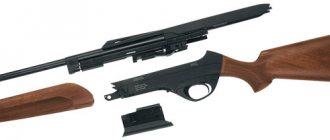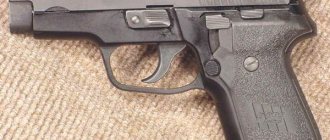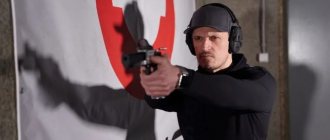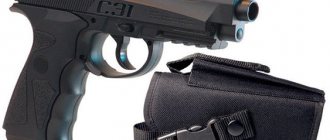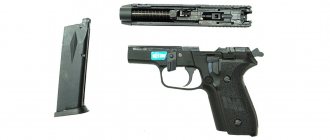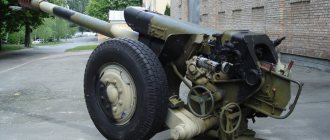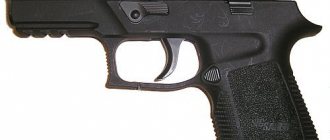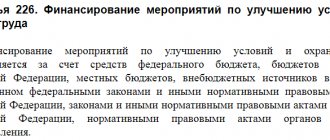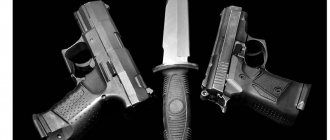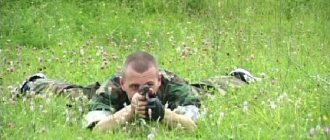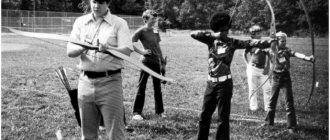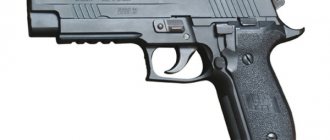Operating instructions for the SAUER 202 rifle
Hunting rifle
Sauer 202
Handling Guide
This Manual includes a complete translation of the instructional material supplied with the gun by the gun manufacturers - Sauer GmBH and SIG. For drawings of series 1...10, which are referred to in the Manual, see the original.
1. General information
The Sauer 202 hunting rifle is a modern high-precision hunting weapon, designed taking into account the latest advances in the field of weapons production. The gun belongs to the class of guns with repeated manual reloading. The trigger release of the gun can be either regular or double, adjustable. When creating the gun, a modular design system was used. The unification of the gun components makes it easy to replace both individual parts and the caliber of the gun as a whole. In addition to the open sight, the gun can also be equipped with an optical sight. In addition, a number of additional accessories can be used. The gun can be adapted for left-handed use.
2. Main distinctive features
2.1. Novelty of the concept (Fig. 2 A and 2 B).
The main concept taken as a basis when creating the Sauer 202 shotgun is the stability of the design and the constancy of the fight.
The gun barrel (24) and the receiver (22) are connected to each other using a clamping screw connection. The trigger assembly (70) is mounted into the receiver as a separate unit. The butt and fore-end are attached to the receiver - this “self-supporting” part of the structure - without connection with each other and without them performing any load-bearing functions, thereby eliminating the influence of natural warping of wood on the accuracy of the weapon.
2.2. Improved gun mechanism (Fig. 2B and 2C).
The receiver is made of steel or aluminum alloy - at the buyer's choice. The box has high rigidity. The bolt (1) and the barrel (24) are rigidly connected to each other, so the pressure of the powder gases is not transmitted directly to the receiver.
The cocking indicator informs about the shutter position. Thanks to the lightweight firing pin and short stroke length, the bolt requires minimal time to move it when loading the gun.
2.3. Compact trigger assembly with safety (Fig. 2 D).
The trigger mechanism, combined with a safety device, is a compact unit inserted into the receiver. The mechanism provides a single-stage or two-stage release. The advantage of this type of trigger mechanism compared to existing samples is that the shooter’s hand during shooting can continuously cover the neck of the butt, and the index finger can remain firmly on the trigger.
The safety device is operated by two separate buttons located in different places. The button for turning off the safety is located inside the safety trigger guard, in front of the trigger. This button is clearly visible and, in addition, is well felt and controlled by the index finger. The button is well protected from accidental pressing, for example, by branches, twigs, etc.
The button for turning on the safety is located in a clearly visible place - at the top of the butt handle. When the safety is off (the gun is ready to fire), a red warning stripe is visible on the surface of this button.
2.4. Lodge.
The stock of a gun, as noted above, consists of two unrelated parts - the fore-end and the butt.
Riklad shotgun - ergonomically shaped, with a pistol grip and a protrusion under the cheek. The butt plate and the butt itself can be quickly separated from the receiver using a special key supplied with the gun. The handguard can also be easily removed and installed using the same wrench. Thus, the Sauer 202 shotgun can be transported disassembled, in a compact rifle case that is convenient for transportation.
Buttstocks of other shapes and lengths can be supplied upon customer request.
3. Technical characteristics.
| 1. Operating principle of the mechanism | Repeated reloading at using a rotating shutter |
| 2. Locking the barrel | Direct bolt-to-barrel connection |
| 3. Caliber | Standard: .243Win, 6.5x55, 6.5x57, 25-06, 7x64, 30-06; ,270Win, .308Win, 9.3×62. Magnum: 6.5×68, 8×68 S., 7. mm; .300Win,300Weath; .375 N&N |
| 4. Full length of the gun | Approx. 1125 mm for standard caliber, 1170 mm for Magnum caliber |
| 5. Barrel length | 600 mm/660 mm |
| 6. Butt length | Approx. 355 mm |
| 7. Lowering the butt relative to the top of the receiver mm, | Comb - 32 mm, middle - 25 rear end - 50 mm |
| 8. Butt retraction to the right | 5mm |
| 9. Trigger force | Direct-ok. 1.3 kg; preliminary - approx. 0.3 kg |
| 10. Magazine capacity | Main: 3 standard caliber cartridges, 2 Magnum cartridges Spare: 5 rounds of standard caliber, 4 rounds of Magnum |
| 11. Weight of the gun without an optical sight | Standard caliber: - with aluminum - 3 kg - made of steel - 3.5 kg Magnum: — with aluminum - 3.3 kg - with steel - 3.8 kg |
4. Preparing the gun for use.
Sauer 202 shotguns are shipped from the factory in tight shockproof packaging.
The gun comes with a bolt, a magazine for 3 (or 2) rounds and a special key. For safety reasons, the bolt and magazine are separated from the gun - a precaution that must be observed in the future when transporting the gun. If the buyer receives the gun in another form, he should assume that the gun is loaded and unsafe to handle. In this case, the gun must be checked and, if necessary, unloaded, and the bolt must be removed from the gun (see paragraph 5). After unpacking the gun, check the operation of the safety buttons and the condition of the chamber. Make sure there are no rounds in the chamber or magazine. Before the gun leaves the factory, all metal parts are coated with factory lubricant. Remove excess grease from metal parts by wiping them with a soft, clean cloth. Using a plastic cleaning rod that matches the caliber of the gun and soft cloth swabs, clean off the grease and wipe dry the Kat of the barrel and the chamber (Fig. 4 B). If the Sauer 202 shotgun was ordered for delivery in a special rifle case, then the stock must also be attached to the shotgun. To do this, attach the neck of the butt to the receiver until it stops (Fig. 4 C). Insert the long end of a special key (1) into the hole in the buttplate and screw the tightening bolt (part 403) with the key (approximately five turns of the key). 5. Handling the gun 5.1.
Fuse (Fig. 5 A and 5 B). The fuse is the connecting part of the trigger mechanism. It is activated by two buttons located separately from one another. To put the gun on safety (in the “safety” position), press the button (76) located at the end of the receiver, in the recess of the butt neck. To remove the gun from the safety, press the button (74) located in front of the trigger, inside the space enclosed by the safety trigger guard. When the button (74) is pressed and recessed into the receiver, the gun is ready to fire. At this time, the button (76) is pulled up and a red warning strip is visible on it.
In Fig. 5 A shows the gun with the safety on (button 74 is extended, visible to the eye and felt with a finger). Button (76) - setting the safety - is pressed down all the way with the thumb of the hand holding the butt handle. Button (74) - releasing the safety - is pressed up all the way with the index finger of the same hand. The red signal ring on the top button is visible: Attention! The gun's safety is off.
5.2. Installation of the valve (Fig. 5 C).
To install the bolt (1) in the gun, you need to cock its hammer. To do this, do the following:
- Insert the thin end of the key (1) into the hole on the side of the bolt lock (12).
- Turn the bolt lock (12) towards cam II located at the end of the bolt stem. The bolt can be installed in the gun only when the safety is removed.
- Remove the gun from the safety catch by pressing the button (74) into the receiver (Fig. 5 A).
- Press the rear shutter delay pin protruding from the top of the trigger block and push it into the block (see section 5.3.-3 below).
- Insert the bolt with the hammer cocked into the receiver, push the bolt all the way forward and lock it by turning the bolt handle down (Fig. 5 D).
To control the correct assembly, perform the operation of opening and closing the shutter, as well as switching the fuse.
When the gun is on safety (button 76 is pressed all the way, and button 74 protrudes from the receiver), it is impossible to open the bolt, since its stem is blocked by the front cylindrical pin of the trigger mechanism.
5.3. Shutter compartment.
To separate the bolt from the gun, do the following:
- Remove the gun from the safety catch (button 74 is pressed up until it stops).
- Rotate the bolt handle all the way up and pull the bolt back approximately half the length of its stroke.
- Recess the rear bolt delay pin (see Fig. 10 A and part 712 on the assembly drawing). The pin can be recessed by pressing upward on the upwardly movable bar protruding from the left side of the safety trigger guard.
- While keeping the sliding bar pressed, remove the bolt from the receiver.
5.4.
Attaching the magazine (Fig. 5E). Insert the magazine (60) from below into the charging window of the receiver, avoiding distortions.
Push the magazine up until it locks with a characteristic click. 5.5.
Store compartment (Fig. 5E). Cover the magazine from below with the palm of your hand.
Using the index finger of the same hand, press the magazine release button (28). Separate the store. 5.6.
Loading the magazine (Fig. 5 G). Press the rear end of the magazine feeder (63) with your finger.
Insert cartridges from the front end of the magazine and push them under the top edges of the magazine (IV). 5.7. Loading a gun
- Remove the gun from the safety lock.
- Open the shutter.
- Attach a loaded magazine
- Close the shutter.
- Put the gun on safety.
Attention! After performing step 4, the gun can fire by simply pulling the trigger. 5.8.
Installation of double release (Fig. 5 H). (Only for gun models with a pin device).
- Remove the gun from the safety lock.
- Use your thumb to pull the trigger forward until it stops.
After retracting the trigger, the trigger mechanism is switched to a double release.
5.9. Turn off double release.
- Put the gun on safety.
- Point the gun towards some kind of bullet-retaining barrier and pull the trigger.
If the additional trigger has been adjusted to a very low force, it may turn off when the fuse is reset.
The double trigger can be disabled carefully if the trigger | pinch it between your thumb and index finger and slowly pull it back.
Attention!
Install the double trigger immediately before shooting, while pointing the gun at the bullet-retaining barrier.
If for some reason the shot was not fired, immediately put the gun on the safety and turn off the double trigger. 5.10. Shooting.
- Point the gun at the target.
- Remove the gun from the safety lock.
- Enable double shutter (if required).
- Fire the shot.
- Reload.
- Put the gun on safety.
5.11. Unloading a gun
- Put the gun on safety.
- Point the gun at the bullet barrier.
- Separate the store.
- Remove the gun from the safety lock.
- Open the shutter. Discard the spent cartridge case or unspent cartridge from the chamber.
- Make sure the chamber is empty.
- Unload the magazine.
In Fig.
5 K shows an unloaded gun. 5.12. Triggering the firing mechanism (After unloading the gun)
- Check the condition of the chamber (see point 4 and Fig. 4B).
- With the shutter open, press the trigger. While keeping the trigger pressed, slowly close the bolt by turning the handle down (Fig. 5 L).
6. Disassembling and assembling the gun.
6.1. Partial disassembly of the gun for cleaning.
- Unload the gun (see paragraph 5.11.)
- Separate the bolt and magazine (see paragraphs 5.3. and 5.5.).
Figure 6 A shows the gun after partial disassembly.
This is enough for normal cleaning of the gun. But if the gun gets into water or gets too dirty, it is recommended to remove the butt and fore-end from the gun for cleaning. 6.2.
Removing the stock (Fig. 6 B). Insert the long end of the key I supplied with the gun into the special hole in the buttplate and unscrew the coupling bolt with this key (part 403 on the assembly drawing).
It takes about five turns to unscrew the bolt. Remove the stock by pulling it back. 6.3.
Removing the handguard (Fig. 6 C). Remove the carrying strap from the gun. Insert the long end of the special wrench into the sleeve (48) of the front swivel and unscrew the forend mounting screw. Rotate the key, inserting and repositioning it until the forend comes off. Pull the forend forward and remove it.
The butt and fore-end are connected in the reverse order (see paragraph 4, Fig. 4 C). Removing the Stutzen forend (Fig. 6 D):
- unscrew the screw (49),
- remove the cover (50),
- further - similar to what was stated above.
6.4.
Attaching the belt (Fig. 6). Insert the rear swivel pin (V) into the stock bushing (50). Press the head of the spring-loaded button (VI) and rotate the swivel slightly so that the locking pin (VII) slides into the socket of the bushing (50). After releasing the button (VI), its head should clearly protrude above the edge of the swivel body.
Attach the front swivel in the same way. To release the strap, firmly press the swivel button (VI), twist the swivel slightly, and pull it out of the sleeve (50). For swivels to function properly, they must be cleaned and lubricated regularly.
6.5. Barrel separation (Fig. 6 B)
.
The barrel can be separated to change the caliber of the gun. The new barrel is installed on the gun without difficulty - no additional adjustment is required. It is only necessary to zero the gun after replacing the barrel.
Replace the barrel in the following sequence:
- Open the bolt and separate it from the gun (section 5.3.).
- Remove the handguard (section 6.3.).
- Loosen the clamping screws (23) using the special wrench provided. Screw 23 A completely unscrew.
- Pull down the liner (29) and remove it.
- Pull the barrel (24) out of the receiver (22).
6.6. Installation of the barrel (Fig. 6 C).
- Insert the barrel into the receiver until it stops. The connecting groove at the end of the barrel must face down when installed.
- Insert the insert (29) into the receiver slot, aligning it with the hole for the 23 A screw.
- Rotate the barrel slightly so that the protrusion of the liner (29) fits into the connecting groove of the barrel. Replace the 23 A screw.
- Lightly tighten the 23 and 23 A clamp screws.
- Insert the bolt into the receiver and close it by turning the handle down (section 5.2.4 and 5.2.-S.).
- Tighten all three clamp screws tightly. The tightening force of the screws, measured with a torque wrench, should be 0.7 kgm (7 Nm).
- Check the operation of the shutter by repeated opening and closing" U
- Attach the handguard.
7. Gun accessories.
The gun accessories purchased at the shooter’s request include:
- Compact rifle case for transporting disassembled
- guns.
- Carrying belt with “Sauer” embossing.
- Open sight (front and rear sights).
- The stock and fore-end are made of wood of varying quality.
- Spare magazines for 2, 3, 4, and 5 rounds.
- A set of parts for replacing the caliber of a gun (see table 7.-1).
Mounts for optical sights in three versions:
- for sights with a rack;
- for sights without a rack, dia. 26mm;
- for sights without a rack, dia. 30mm.
Table 7.-1
| Barrel caliber | Store type | Shutter type | |||||
| A | B | C | D | A | B | C | |
| 6,5×57 | X | X | |||||
| 28 -06 | X | X | |||||
| .270 Winch. | X | ||||||
| 7×64 | X | X | |||||
| .30-06 | X | X | |||||
| .308 Winch. | X | X | |||||
| .243 Winch. | X | X | |||||
| 6,5×55 | X | X | |||||
| 9.3x62 | X | X | |||||
| 7 mm Rem. | X | X | |||||
| 8x68S | X | X | |||||
| 6,5×68 | X | X | |||||
| .300 Winch. | X | X | |||||
| .300 Weight. | X | X | X | ||||
| .375 H&H. | X | ||||||
| .416 Rem. | X | X | |||||
8. Caring for your gun.
If the following care instructions are followed, the Sauer 202 shotgun will last for many years, even under heavy use.
8.1. Barrel and chamber (Fig. 8 A).
After each shooting, clean the bore and chamber. Clean the barrel from the rear end. [Use a cleaning rod appropriate for the caliber of the gun and special gun oils for cleaning.
Warning: Never clean the barrel from the muzzle side. Do not use steel brushes for cleaning as they will damage the polished surface of the bore. Make sure that no carbon deposits form in the barrel. Use special gun cleaners to clean the barrel from carbon deposits. Lightly lubricate the bore and chamber when the gun is not in use.
Before each shooting, wipe the bore and chamber dry to remove any grease.
8.2. External metal surfaces.
Proper care of external metal surfaces is especially important if the gun has been used during wet weather or has been in contact with sweaty surfaces on the shooter's body.
After each use of the gun, wipe the outer metal surfaces with a soft cloth soaked in gun oil or coat them with a special lubricant.
8.3. Butt and forearm.
The wooden parts of the Sauer 202 shotgun have a satin finish. Caring for the stock and forearm is simple, but should not be neglected. From time to time, the surfaces of the butt and fore-end must be coated with wood-protective compounds. Gun oil is not suitable for this purpose.
9. Adjustment of the trigger mechanism.
9.1. Direct descent.
The straight trigger should only be adjusted by an experienced gunsmith.
9.2. Double release.
(adjustable only for gun models with a pin device). The preliminary trigger is adjusted at the factory to a force of 0.3 kg. The trigger force can be changed using the screw (89) (Fig. 9 A):
- to reduce the trigger force, turn the screw (89) clockwise;
- to increase the trigger force, turn the screw (89) counterclockwise;
Warning:
For shooting in the field, especially in the cold season, the trigger should be adjusted to a greater force than for shooting in a shooting range, since the index finger in the cold becomes less sensitive to the trigger.
10. Operation of the gun mechanism.
The perfect design of the Sauer 202 shotgun is based on many years of experience in weapons production combined with the latest technical advances. Few, but well-designed and accessible parts of the gun ensure simple and safe handling. To better understand the interaction and sequence of operation of the parts of the mechanism, a more detailed description is given below.
Fuse (Fig. 2D and 10 A)
To put the gun on safety, the button (76) is pressed down with the thumb until it stops.
At the same time, a button (74) is pulled down from the trigger housing, which can be easily felt and controlled with the index finger of the hand. Both buttons move simultaneously using a rocker (double-armed lever) located on the right side of the trigger block. The trigger block is attached to the receiver with two studs.
Shutter (Fig. 10 L)
The bolt of the gun is opened by turning the handle up until it stops and then pulling it back. Simultaneously with turning the handle upward, the bolt's impact mechanism, consisting of a hammer, firing pin and mainspring, will spring up.
The striker-type hammer (3) is cocked as a result of the pressure exerted on it by the beveled cam (XI) while turning the bolt handle. The trigger, under the pressure of the cam bevel, moves back, at the same time retracting the firing pin connected to it and compressing the mainspring.
When the cocked bolt is pulled back under hand pressure, the bolt ejector removes the spent cartridge case (or unspent cartridge) from the chamber. When the bolt is pulled out of the receiver to its full travel length, the spring-loaded bolt deflector deflects the spent cartridge case and ejects it from the gun.
The rear movement of the bolt will be stopped by a cylindrical locking pin protruding from the trigger mechanism block and sliding in the longitudinal groove of the bolt stem.
When moving forward (closing) again, the bolt, along the travel path, grabs a new cartridge from the magazine and directs it into the chamber of the barrel. The bolt is pushed into the receiver until it stops, after which the bolt handle is turned down. When turning the bolt handle, the bolt is connected to the barrel. The impact mechanism is delayed by the sear and remains cocked. If these actions are not followed by pressing the trigger and no shot is fired, then the gun must be immediately put on safety.
The bolt can only be reopened after the gun has been released from the safety catch.
List of parts
When ordering spare parts, please indicate: gun model, serial number, caliber, part numbers and their names, as well as left or right-handed version.
| No. of parts | Name of parts |
| 100 | Striker Mounting Pin |
| 102 | Trigger |
| 103 | Thrust coupling sleeve |
| 104 | Action spring |
| 105 | Drummer |
| 106 | Reflector pin |
| 107 | Reflector spring |
| 108 | Thrust pin |
| 109 | Ejector |
| 110 | Ejector spring pusher |
| 111 | Bolt |
| 112 | Shutter lock |
| 113 | Receiver assembly |
| 200 | Magazine ejector spring |
| 201 | Receiver body, steel or aluminum |
| 202 | Clamping screws - 3 pcs. |
| 203 | Magazine latch |
| 204 | Guide pin |
| 205 | Magazine latch spring |
| 206 | Magazine release button |
| 207 | Insert for fixing the barrel Trigger mounting pins - 2 pcs. |
| 208 | Insert for fixing the barrel |
| 209 | Safety button - top |
| 210 | Screw stud |
| 211 | Trunk |
| 301 | Spacer |
| 302 | Pan head screw |
| 303 | Rear sight |
| 304 | Pan head screw |
| 305 | Rear sight base |
| 306 | Pan head screw |
| 307 | Drop front sight with base |
| 308 | |
| 400 | Stock assembly |
| 401 | Butt |
| 402 | Guide sleeve |
| 403 | Pinch bolt |
| 404 | Notched washer |
| 405 | Thrust washer |
| 406 | Taper head wood screw |
| 407 | Sleeve for attaching the swivel |
| 408 | Butt pad |
| 408 | Screws for the butt plate - 2 pcs. |
| 500 | Forend assembly |
| 501 | Mounting screw |
| 502 | Handguard |
| 503 | Screw bushing for swivel |
| 510 | Forend tip "Stutzen" |
| 600 | Complete store |
| 601 | Magazine cover |
| 602 | Magazine spring |
| 603 | Store feeder |
| 604 | Magazine box |
| 700 | Double escapement mechanism |
| 701 | Descent regulator (stecher) |
| 702 | Axle of sear and release regulator - 2 pcs. |
| 703 | Compression spring |
| 704 | Trigger hook (sear) |
| 705 | Cylindrical pin - sear travel limiter |
| 706 | Trigger |
| 707 | Trigger axis |
| 708 | Compression spring |
| 709 | Adjusting washers - 2 pcs. |
| 710 | Left rocker arm (double-arm lever) |
| 711 | Movable bar - rocker arm pusher |
| 712 | Shutter lag |
| 713 | Shutter delay spring |
| 714 | Fuse rod |
| 715 | Cylindrical pin - 2 pcs. |
| 716 | Pressure spring |
| 717 | Stop pin |
| 718 | Release lever |
| 719 | Fuse rod pusher with delay bolt pin |
| 720 | Spring guide rod |
| 721 | Trigger spring |
| 722 | Spring adjusting screw |
| 723 | Right rocker arm short |
| 724 | Spring guide rod |
| 725 | Rocker spring |
| 726 | Long right rocker arm |
| 727 | Rotating insert for spring stop |
| 728 | Trigger frame |
| 729 | Adjustment screw |
| 730 | Video clip |
Safety regulations
1. The shooter must always assume that the gun is loaded and ready to fire until he is personally convinced otherwise.
2. Use only high-quality ammunition for shooting that exactly matches the caliber of the gun.
3. During any manipulations with the gun, keep the muzzle of the gun pointed in a safe direction.
4. Never point a gun at people or any objects that you do not intend to shoot at.
5. Load the gun only immediately before shooting.
6. Do not put your finger on the trigger until you see the target.
7. Keep the gun and its ammunition in separate places under lock and key.
8. Never leave your gun unattended. Keep the gun out of the reach of children.
JPSauer & Sohn, GmbH (Part III)
(End. Beginning in the articles “JPSauer & Sohn, GmbH (Part I
) and (
Part II
)")
Sauer 90 and Sauer 92 carbines
Weatherby-Sauer Mark V carbines did the company a good service: it acquired the image of a manufacturer of powerful and reliable carbines. The prototype was an American model, and the carbines were equipped with a very powerful, American-style bolt and cold forged barrel. These carbines were chambered in a variety of calibers from .243Win to 8x68S, including powerful magnum cartridges such as .300Weath Mag. The carbine was so successful that hunters still use it today, despite the fact that there are modern models now.
Sauer 90 carbine with long stock
The Sauer 90 carbine, which replaced the Sauer 80 model in production, is equipped with a rear-locking bolt, patented by the company. The bolt is equipped with movable lugs installed in the rear part of its body near the handle, and locks the barrel chamber in the bolt box. The lugs rise when locking, that is, when the bolt moves forward to the extreme position, and fall when opening, that is, when the bolt moves backward. This locking system required the creation of a very powerful and long bolt box. When reloading, the bolt rotates at a relatively small angle, only 65 degrees, and provides almost instantaneous reloading, and the rotation angle of the bolt handle allows you to install any optical sights. The bolt itself is released when the trigger is pressed. The safety button is installed on the upper shank of the block.
Sauer 90 carbines are always popular and have not been discontinued for many years. In its standard version, weighing almost 3.7 kg, it is manufactured for cartridges from .270Win to 8x57JS. These models are equipped with a barrel with a length of 600 mm and a diameter of 15 mm, and for a carbine chambered for the 9.3×62 cartridge, a barrel with a diameter of 17 mm is intended.
Sauer 90 magnum carbines weighing about 3.8 kg are equipped with a barrel 660 mm long, and in recent years 650 mm long, and 16 mm in diameter. It is designed to fire cartridges from 6.5x68 to .300Weath Mag, and until 2005 this list also included the .338Win Mag cartridge. For the more powerful model weighing 3.9 kg and chambered for the .375H&H Mag cartridge, a barrel length of 600 mm is intended.
The solid large-caliber Sauer 90 Safari carbine is manufactured for magnum cartridges of only one caliber, .458Win Mag. It is designed for shooting with open sights; a rear sight and front sight are installed on a 600 mm long barrel. Despite its weight of 4.5 kg, this well-made carbine is comfortable and easy to handle, for example, the bolt is removed when the trigger is pulled without any unnecessary movement.
Sauer 92 carbine with a short barrel length of 510 mm
The compact Sauer 90 Stutzen carbines are equipped with a barrel length of only 510 mm, which is protected by a long stock of the Stutzen type. The front part of the forend rests on a metal tip mounted on the muzzle of the barrel. Sauer 90 Stutzen carbines weighing about 3.6 kg are designed to fire cartridges of various calibers from .243Win to 9.3x62.
The modern Sauer 92 carbine was created in the early 2000s on the basis of the well-known Sauer 90 model. It has exactly the same bolt as its predecessor. The Sauer 92 carbine is designed to develop the hunting weapons market in Southern Europe - Italy and Spain, and mainly the design of the stock and individual parts were redesigned. The stock has acquired a more streamlined shape, a steeply cut pistol-shaped neck on which the shooter's palm fits comfortably, and an angular cheek piece of the fashionable "Bavarian" type. The ergonomic, flat bolt handle is bent back to reduce hand movement when reloading.
The Sauer 92 carbine is produced with a barrel of only two sizes, 600 mm long for cartridges from .243Win to 9.3×62 or 660 mm long for magnum cartridges from 6.5×68 to .300Weath Mag. In recent years, the company has revised and unified the standard range of barrels, and Sauer 92 Magnum carbines are equipped with a barrel length of 650 mm. However, this concerns the technology conditions and has virtually no effect on ballistics. The weight of the carbine, depending on the caliber of the cartridge and the length of the barrel, remained the same, as on the Sauer 90 prototype.
Sauer 200 and Sauer 202 carbines
The Sauer 200 repeating carbine, with which the company began a new expansion of the arms market in the 1980s, remained in production for almost ten years. Its modular design with an interchangeable barrel and separate stock and handguard turned out to be almost universal. It made it possible to produce a whole range of Sauer 200 carbines chambered for cartridges of various calibers, from .243Win to 9.3×62, as well as the magnum category from 7mm Rem Mag to .300 Weath Mag. Some samples were made for even more powerful .375H&H Mag cartridges, and the Sauer 200 Safari model was chambered for .458Win Mag cartridges.
The barrel chamber of the Sauer 200 carbine is locked directly in the barrel by a bolt with six lugs located in front of the stem, and large loads are not transferred to the bolt box when fired. This locking allowed the company to produce this carbine in two versions with different bolt boxes: Sauer 200S with a steel box and Sauer 200L with a box made of a lightweight aluminum-based alloy.
The Sauer 202 carbine is a further development of the Sauer 200 model with the same locking and the same bolt. Its design is still based on a modular principle: barrel, bolt box, bolt, trigger block, magazine, stock and forend. The range of acceptable calibers was expanded for it, and an ergonomic stock with a high upper ridge, a protrusion under the cheek and a steeply cut pistol-shaped neck was installed on it. Now the Sauer 202 carbine is produced with such a variety of main parts that the total number of all models exceeds several dozen.
Long-lived - the Sauer 202 repeating carbine The
Sauer 202 carbine in the standard version for cartridges from .22-250Rem to 9.3×62 is equipped with a barrel 560 or 600 mm long with a diameter of 15 mm. Models designed to fire powerful cartridges from 6.5-284Norma to 8x68S are equipped with a 600 or 650 mm long barrel with a diameter of 16 or 17 mm. Big Game carbines chambered for .375H&H Mag or .416Rem Mag have a barrel length of 600 mm and a diameter of 19 mm, and the carbine chambered for .458 Lott caliber has an even heavier barrel with a diameter of 22 mm. A short barrel with a length of 510 mm is included in the Sauer 202 Stutzen, Sauer 202 Forest and Sauer 202 Highland carbines, and the shortest barrel with a length of 460 mm is installed on the new Sauer 202 Hardwood model.
Modern Sauer 202 carbines are produced primarily with a steel bolt box, and only the Outback, Forest and Highland models are equipped with a bolt box made of a lightweight aluminum-based alloy. These three carbines accept only the 9.3x62 cartridge as the most powerful, and they are not manufactured for magnum cartridges. Their weight is on average 3.0 kg, and the lightest is the Sauer 202 Highland model weighing only 2.7 kg. The weight of carbines with a steel bolt box is approximately 3.5 kg.
An invariably popular material for the manufacture of stocks and fore-ends is walnut wood of various types and textures, including expensive ones, complemented by polymer synthetics. It is used to make the stock and forend in a dark, almost black color for the all-weather and compact Sauer 202 Classic Synthetic, Sauer 202 Hardwood and Sauer 202 Outback models. However, another compact carbine, the Sauer 202 Stutzen, is equipped with a long, full-barrel forend, protected by a metal tip, and a stock made of walnut.
The Sauer 202 Alaska model, which was widespread until recently, was equipped with a stock and forend made of ply laminated wood. This carbine is well protected from any external influences, bad weather, dents, scratches: the surface of the barrel and bolt box is phosphated, and a polymer coating of the Ilaflon type was applied to it.
For accurate shooting at extreme hunting distances, the company produces the Sauer 202 Jagd Match carbine with a powerful heavy barrel. Barrel dimensions: length 600 mm and diameter 17 mm or length 670 mm and diameter 21 mm, selected depending on the caliber of the cartridge being tried on .22-250Rem, .243Win, 6.5×55, .25-06Rem, .308Win or .300Win Mag. There are no open sighting devices on this carbine; it is intended for shooting only with an optical sight. The carbine is quite heavy, its weight is at least 3.6 kg, and the model chambered for magnum cartridges weighs up to 3.9 kg.
A separate group consists of collapsible carbines Sauer 202 Take Down (Collapsible). They are disassembled into two parts: one is a bolt box with a stock and part of the forend, lined with a metal clip, the second includes the barrel and part of the forend, lined with a reciprocal metal clip. By the way, the barrel part of the forend is also removable. During assembly, the barrel fits deeply into the bolt box, while the guide is the rod at the end of the forend. This system is very promising, since the disassembled carbine is compact and convenient for transportation, and, most importantly, it is very easy and quick to assemble.
The company produces several collapsible models, the main ones being the Sauer 202 Take-down Select and Sauer 202 Take-down Forest carbines. The complex design determines the mass of these models - they are heavier than their conventional counterparts. Thus, the Sauer 202 Take-down Select model with a 600 mm barrel for cartridges from 6.5x55 to 9.3x62 weighs on average 3.8 kg, and for powerful cartridges .375H&H Mag and .416Rem Mag its weight is already 4.1 kg. The heaviest carbine is the Sauer 202 Take-down Hatari - made by Big Game and chambered for .458 Lott, it weighs 4.4 kg. This cartridge is now one of the most promising for hunting large animals; it is loaded with a bullet weighing 32.4 g in an almost cylindrical case with a belt and a groove and causes less recoil than its common classmate .458Win Mag.
The company produces a number of sports models based on hunting rifles. The first sporting carbines, for which the Sauer 200 hunting model was the prototype, were models with a heavy, thick barrel 670 mm long: the Sauer 200 UIT chambered for .308Win and the Sauer 200 TR Match for firing 6.5×55 and .308Win cartridges. These sporting carbines were equipped with a voluminous stock with a steep pistol-shaped neck and an adjustable upper comb and butt plate.
The modern group of sporting rifles now includes a significantly larger number of models, starting with the first Sauer 200 TR Match, which is still in demand. The design is subject to shooting conditions, and it is almost impossible to recognize elegant hunting prototypes in these complex designs. They are chambered for the most common cartridges in sports: .223Rem, 6.5×55, .308Win and 7.5×55, and the Sauer 202 Target Magnum carbine is also chambered for the .300Win Mag cartridge. As a rule, these are heavy carbines weighing up to 5.5 kg; they are equipped with a thick round barrel 670 mm long. Numerous models differ mainly in their sighting devices and stock design.
The Sauer 200 TR Match, Sauer 205 Super-target and Sauer 205 Sport carbines are equipped with diopter sights. The Sauer 202 Target, Sauer 205SSG, Sauer 205 Phantom and Sauer SSG 3000 models are produced for shooting only with optical sights. Sports models are equipped with an ergonomic, almost orthopedic stock, the design of which takes into account the build of a person, as well as his instinctive actions when shooting. The stock is made from layered laminated wood, not exposed to the influence of the external environment, and recently more and more from synthetic materials. It is equipped with a bipod, a wide, voluminous, often ventilated forend, an adjustable butt plate and an upper comb.
All sporting carbines are equipped with detachable magazines that can hold 4 or 5 or even 10 rounds, with the exception of single-shot models designed for single-shot Bench-rest shooting. This type of sport shooting at extreme distances of up to 1000 and 1500 m with emphasis on a special table is now rapidly developing, and for this purpose cartridge companies produce cartridges with a high-speed bullet with a flat trajectory, for example 6mm Norma BR. All branded sports carbines chambered for this cartridge are single-shot.
Self-loading carbine Sauer 303
Self-loading carbine Sauer 303 in basic version
The company is so famous for its repeating carbines that the appearance in 2006 of the self-loading carbine Sauer 303 was completely unexpected for both hunters and gunsmiths. The company did not give up its gained positions and, based on the Sauer 202 carbine, created a new model, in which the design of the analogue is clearly visible. Just like on the base model, separate stocks and fore-ends are mounted on the bolt box of the new Sauer 303 carbine. The first samples of the Sauer 303 were designed to fire the most popular cartridges, chambered in grooved cases.
The Sauer 303 self-loading model with a gas-operated reloading mechanism is equipped with a whole set of new components registered by the company. First of all, this concerns the shutter with Intra Lock devices for internal blocking of the firing pin and SCS for manual shockless release or cocking of the striking mechanism using a gate mounted on the shank of the bolt box. Reliable reloading is guaranteed by the Smart Tube unit for selecting powder gases from the barrel. For external development of the barrel, the company has mastered the new Nitrobond X technology, based on plasma nitriding of the surface. Fast and, most importantly, accurate installation of the optical sight is guaranteed by the ISI mount for the bracket supports, made on the bolt box.
Doubles and tees
In addition to a variety of hunting carbines, the company produced several models of breech-loading weapons with a folding barrel block. Thus, until the 1980s, they produced the Sauer 54 over/under with a block of combined barrels - 16-gauge shot and rifled for 6.5x57R or 7x65R cartridges, locks in the block and top locking with a double bolt of the Kersten system. A block of barrels 635 mm long, a block made of a lightweight aluminum-based alloy, and a trigger mechanism with two triggers were installed on the double. It was the lightest model of the company, its weight was only 2.7 kg.
Self-loading modern carbine Sauer 303
In the 1990s, after the company merged with the SIG company, the Sauer 97 vertical rifle appeared with manual cocking of percussion mechanisms and a combined block of barrels: smooth and rifled, or rifled of various calibers. Another company from the SIG holding took part in the creation of this double. The upper barrel was intended for firing shotgun cartridges, or in the rifled version, cartridges of relatively small calibers, from .22Hornet to 6.5x57R, the lower barrel was designed for more powerful cartridges, but not larger than the .300Win Mag caliber. This model was equipped with a block of barrels 600 mm long, and it weighed about 3.3 kg.
A relatively small group of Carl Gustaf-Sauer models - over-and-unders, doubles and tees - were produced in the 1970s and 1980s for Sweden, although they were also supplied to other countries. The weapon is made in the traditional German style and is equipped with a stock with a pistol-shaped neck and a protrusion under the cheek:
- horizontal bars with top locking with a Greener system bolt,
- vertical frames with double bolt Kersten system,
- tees with a barrel block consisting of two upper shotguns and a lower rifled one, and a barrel adapter installed on the upper shank of the block.
On models with a combined block of two or three barrels, rifled ones were designed for cartridges from .222 Rem to 7x65R, and smooth ones were designed for shot cartridges of 12 or 16 gauges.
The unchanged long-term signature model, the Sauer 3000 tee, is a classic three-barreled shotgun with a block of barrels consisting of two upper smooth ones and a lower rifled one. The different versions differ in finish, types of walnut wood on the stock and fore-end, and engraving. The modern model, produced back in 2003, was equipped with a block of barrels 635 mm long with an upper 12-gauge with chambers 70 mm long, and a lower one designed for firing various cartridges from .243Win to 9.3x74R. The 16-gauge smoothbore tee offers a narrower range of bullet cartridges from 6.5x57R to .30R Blaser. A magazine with a cover for cartridges for a rifled barrel was often installed in the lower ridge of the stock. The weight of the tee reaches 3.4–3.5 kg, depending on the caliber of rifled and smooth barrels. In recent years, only the high category Sauer 3000 Luxus tee was produced, decorated with a hand-made plot engraving.
The Sauer 3000 three-barreled gun has a triple locking of the barrel block: the upper one with a Greener system bolt, the lower one with a double frame on under-barrel hooks. The side cheeks on the shoulders of the block are an additional element connecting the block to the block. The tee was equipped with Blitz system locks with V-shaped mainsprings, which at one end rest directly on the trigger. The locks are cocked when the barrel block is opened. Then they changed the design of the lock for the lower barrel and introduced separate cocking of the locks: for the upper barrels, as before, when opening the block, for the lower barrel, manually with a gate placed on the upper shank of the block. This system was offered already in the early 1990s and became the main one. The safety button, independent of the lock cocking system, is installed on the left side of the stock neck near the block.
Since 1972, the Sauer-Colt 3000 tee, created on the basis of the company’s classic model with a block of two upper smooth ones and a lower threaded one, has been supplied to the US market. The tee was equipped with standard Blitz system locks. A model with a rifled barrel chambered for .243Win or .30-06Sprg caliber cartridges was sent to the American market. For the European market, a tee with a rifled barrel was intended for a wider range of cartridges, but no larger than caliber 9.3x74R. The weight of the Sauer-Colt 3000 tee with a barrel block length of 635 mm was about 3.3 kg, depending on the caliber of the barrels.
Smoothbore guns
The small group of branded smoothbore weapons consists mainly of over-and-unders. Relatively rare horizontal guns were once represented by the Sauer-Beretta VIII 12-gauge shotgun, which is actually a copy of the previous branded Sauer VIII double-barreled shotgun. With a typical block of barrels 710 mm long, this model weighed at least 3.0 kg. Modern horizontal guns are high-end Sauer Meisterwerk Flinte shotguns with backing locks on the side plates. They are made mainly to order; annual production is limited to no more than 10 guns of 12 or 20 gauge. Engraving is entrusted only to the best craftsmen known outside of Germany.
Hunting over-shooter Sauer-Franchi Diplomat
Based on the common Italian model, the company created another over-shooter - the Sauer-Beretta Imperial. It was a typical 12-gauge hunting rifle, equipped with a stock with a pistol-shaped neck, and a block of barrels 720 mm long was installed on it. The weight of this vertical was suitable for its purpose and was about 3.2 kg.
For almost two decades, the company produced a series of Sauer-Franchi over-and-under locks with locks equipped with spiral mainsprings and a trigger mechanism with a single trigger. They first appeared in 1984, and only recently they were replaced by a new smoothbore over/under. For hunting, at first, four Sauer-Franchi 12-gauge models were made with ringing, meaningful names: Standard, Regent, Favorit and Diplomat, which differed in decor and types of walnut on the stock. They were equipped with a standard block of barrels 710 mm long with a ventilated aiming rib 7 mm wide, a block made of steel, and ejectors. The basic Sauer-Franchi Standard over/under, the only model without ejectors, was a gun with a smooth, dark, almost black finish and straight-grained but dense walnut on the stock and fore-end. The Sauer-Franchi Diplomat model was characterized by fine engraving with small arabesques and bouquets of roses.
Three Sauer-Franchi 12-gauge models marked Sporting, Trap and Skeet were designed for various types of sports shooting. In terms of the design of locks and ejectors, sporting shotguns were no different from hunting shotguns. They were equipped with a ventilated aiming rib with a larger width of 10 mm, specialized stocks, as well as barrel blocks of various lengths: for a trench stand of 740 mm, for sporting and a round stand of 710 mm.
Later, the company produced only two models of 12-gauge smoothbore over/unders with ejectors: Sauer-Franchi Diplomat and Sauer-Franchi Favorit. They were still fitted with a 710 mm long barrel block with chrome-plated bores and 70 mm long chambers. These guns weighed about 3.2 kg. The same later models received a barrel block with a 10 mm wide rib and 76 mm long chambers. The modern trend of making blocks from an aluminum-based alloy did not affect them; the blocks on Sauer-Franchi shotguns were only made of steel, and the verticals themselves weighed about 3.5 kg. The increase in mass is determined by the greater thickness of the barrel walls, which must withstand firing with magnum category shotgun cartridges. Both models differ mainly in the finishing of the block and the type of walnut on the stock and fore-end, with the more expensive Sauer-Franchi Diplomat over/under being decorated with engraving, the design of which is complemented by gold figures.
Now in the production of hunting weapons, the company abandons models with double names and relies on its own - the JP Sauer & Sohn brand does not require additional support. A new shotgun appeared in 2005, this Sauer Sterling over/under replaced all previous branded smoothbore over/unders. The model is made in accordance with modern conditions of hunting shooting in Europe: it is designed for shooting with cartridges loaded with steel shot, and has passed all the necessary tests.
The Sauer Sterling shotgun is available only in 12 gauge and is equipped with a 710 mm long barrel block with 76 mm long chambers, ejectors and interchangeable muzzle devices in five sizes. Its weight is significantly less than its predecessors and is only 3.2 kg. It is designed for long and intense shooting, and for cooling, long ventilation slots are made in the connecting side bars of the block. A 10 mm wide ventilated sighting rib with widely spaced supports is installed on the upper barrel of the unit, almost universal for a variety of hunting and sport shooting.
The block with high profiled sidewalls differs from previous Sauer Franchi shotguns by the outward ends of the axle shafts and a wide cutout in the rear. The block is set low in the block, rests on the sidewalls of the block with longitudinal ribs, under which the ejector legs are located, and is locked with a lower wide bar. This gun has its own universal trigger mechanism with one trigger. A voluminous smooth fore-end with a button on the end, the shape of the front part of the block with a large radius of the surface with which the block comes into contact with the frame of the fore-end, a stock with a pistol-shaped neck and an applied elastic butt plate form an impeccable image of the branded vertical.
***
Two hundred and fifty years of producing a variety of hunting weapons have made JP Sauer & Sohn GmbH one of the leaders in the world arms production. Hunters still take pride in their shotguns and carbines bearing the iconic JP Sauer & Sohn logo.
E.G. Kopeiko
Sauer for tough conditions Sauer 202 Outback
The Sauer 202 Outback differs from other versions of this model by the presence of a durable plastic stock, a lightweight barrel and a low total weight of only 2.9 kg. The carbine is quickly disassembled and can be equipped with either one barrel or a combination of interchangeable barrels of various calibers.
In Russia, this model is most often available in two calibers: .30-06 and 9.3×62. According to the manufacturer, the Sauer 202 Outback is optimally suited for heavy and fast hunting, because... it is as lightweight as possible, the polymer stock of the rifle perfectly resists temperature fluctuations, scratches and shocks, and a standard mechanical sight can serve as a backup for the optics if it is damaged. Sauer. History of the company. The company “Sauer and Sohn Gmbh” deservedly bears the honorary title of one of the most prominent weapons legends of global importance. The company was founded in 1751 in the city of Suhl, which since the 14th century was known as one of the largest European centers of metalworking, and since the 16th century as a supplier of weapons. Here it is difficult to disagree with the opinion that it was the concentration of means of production and personnel that “allowed local arms manufacturers to apply the most advanced developments in the field of metallurgy in their workshops and train real gunsmiths and create their own unique corporate culture.” It sounds pretentious, but that’s how it happened. And everywhere: the gunsmiths of our country followed the same path. And in 1873, Johann Paul Sauer and his sons Rudolf and Franz registered a company, which received the official name “Johann Paul Sauer und Sohn”. In this form, or rather under the full name “JP Sauer & Sohn, Suhl”, the factory became known as one of the most important manufacturers of high-quality hunting weapons in Europe. The company's products were truly competitive, so popularity outside Germany was not long in coming. Moreover, the company produced both hunting and military weapons. Sauer's rifles began to gain prominence more than 130 years ago when the company won an award for the rifle at the 1881 World's Fair. Then Sauer began collaborating with the well-known Friedrich Krupp, together with whom the Sauer company developed special grades of steel for the production of its weapons. Since the early 1970s. The Sauer plant produced the Sauer 80 model, which was distinguished by its original shutter design and excellent workmanship. In the 1990s. this model was replaced by a modification of the Sauer 90. In the 1980s. the Sauer 200 model appeared, which has a modular design. This design was improved in 1993. This is how the Sauer 202 appeared. Today, the Sauer factory is part of the Blaser-Mauser-Sauer group of companies and produces up to 400,000 units of products per year. Sauer 202 Outback. Design features. The carbine is a classic type weapon and is designed for hunting in any terrain. As befits a modern rifle, the Sauer-202 can use a wide range of ammunition to suit every taste and for any purpose. Standard calibers: 9.3×62; .308 Win; .270 Win; .30-06; 7x64; 25-06; 6.5×57; 6.5x55 and 243 Win. Available magnum calibers: .375 H&H; 300 Weight; .300 Win; 7 mm; 8x69S and 6.5x68. The rifle is available in the following modifications: Classic, Forest, Outback, Avantgarde, Elegance and Advanset Gold. Depending on the caliber and model, the barrel length can vary from 510 to 660 mm, the total length of the carbine - from 1025 to 1170 mm. Main magazine capacity: 2 magnum cartridges or 3 standard caliber cartridges. Another cartridge can be pre-driven into the barrel. According to the developers of the 202nd model, when working on the carbine they tried to achieve a stable and accurate firing, as well as maximum reliability of the bolt group. A distinctive feature of the Sauer-202 is the ability to change the barrel. The receiver and barrel are connected by a clamping screw connection. The trigger is mounted in a separate block and attached to the receiver. Another feature of the rifle is its autonomous butt and fore-end, freed from the functions of the supporting structure. According to advertising statements, this avoids changes in the combat characteristics of the rifle due to deformations of the wooden stock. In practice, this is not entirely true, but more on that below. The rifle's receiver can be made of traditional steel or an aluminum alloy. The Germans claim that receivers are highly durable regardless of the material. Considering the barrel locking that has already become common in modern German rifles, this is so. Therefore, the choice of box materials is a matter of personal preference. The bolt has 6 lugs, arranged 3 in 2 rows. This ensures reliable locking at a 60-degree handle lift angle. The extractor is spring-loaded, the reflector is located in the shutter cup. To remove the shutter, you must press the stopper button located on the left at the base of the trigger guard. The configuration of the rear part of the bolt group is reminiscent of the MTs-19-09 or the well-known MTs-20-01 gun. A red indicator indicates that the striker is cocked. The magazine body is made of sheet steel, the lid is plastic. Removal is accomplished by pressing a button in the front of the magazine well, after which the magazine literally “jumps” out of the rifle. The cartridges are arranged in a single row; filling the magazine and attaching it to the weapon does not cause any difficulties. The rifle trigger is adjustable. The descent is excellent. The trigger is activated when the firing pin is cocked by moving the trigger forward. The fuse is integrated into the trigger block and is activated by pressing a button in the receiver shank. The firing pin and bolt are released by pressing a button located at the bottom of the trigger guard, just in front of the trigger. Given the fairly large size of this button, its protection with a bracket was not chosen by chance. A switched-off fuse is clearly identified visually and tactilely. The rifle barrel has fullers. In addition to lightening the barrel, providing additional strength and increasing the surface area of the barrel for faster cooling, these longitudinal grooves also serve an aesthetic function. The bore is without chrome plating. The design of the rifle is modular, i.e. suggests the possibility of replacing the barrel. The open sight is presented in the form of classic fitting devices - front sight and rear sight on high bases, which have an auxiliary value, because This rifle still requires the use of an optical sight. The rear sight is adjusted in a dovetail along the horizon and aimed at a certain distance, usually 100 m. The front sight is adjusted vertically by rotating the screw. In this case, the rear sight fixing screw has a slot for a slotted screwdriver, and the front sight screw requires a hex socket wrench. The butt of the rifle has a classic shape with a pistol grip and a Monte Carlo comb. The comb is tilted forward, which prevents injury to the shooter’s cheekbone during recoil. The forend and butt can be separated from the receiver using a special key. This allows you not only to transport the rifle in a compact suitcase, but also to quickly replace the expensive wooden stock with a cheaper, but much more practical plastic, turning an elegant rifle into a utilitarian tool. Advantages and disadvantages Among the disadvantages of the Sauer 202, one can most often note the insufficient, by modern standards, accuracy of the rifle, fluctuating between 30-50 mm at 100 m in a series of 3-5 shots. In principle, this is a good indicator for a hunting rifle, but given the cost of the 202 model, I would like better results. Diligent owners sometimes break the screws securing the buttstock and forend - when installing them, it is advisable to use a torque wrench according to the instructions. There are complaints about instability of the action due to swelling of the wooden fore-end of the rifle or excessive tightening of the fastening screw. This problem can be “treated” either by additional sampling of wood followed by impregnation with oils or by replacing the wooden stock with a plastic one. The advantages of the rifle are: low weight, excellent balance and ergonomics, modular design and high quality workmanship. Among the advantages of the Sauer 202, one can note its unique image component. Summary The Sauer 202 Outback, which you see in the photographs for this article, is used for hunting in Primorye and Sakhalin Island. Initially, the rifle was equipped with a Swarovski Z6i 1-6x24 “corral” optical sight. Even with an optical sight, the weapon has excellent balance and the ability to shoot effectively from hand. Ergonomics are at a decent level. Excellent quality of processing of metal surfaces. All the hardware is packed tightly into the stock, without gaps. The tempo is good and the plastic is good, which avoids the disadvantages of wood. Over several years of hunting in rather unfavorable conditions, the rifle never failed, and the .30-06 cartridge showed its sufficiency in hunting any animal, up to 400 kg Sakhalin bears. This specimen was never shot specifically for accuracy, but sighting series from not the most convenient positions usually fell within 50-60 mm. Of course, the cost of a rifle, even in plastic and with one barrel, does not make it accessible to a wide range of hunters, but you still have to pay for the Sauer name. Hunting
Yuri Maksimov
